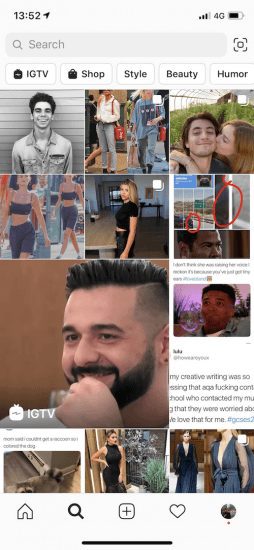Guest Post by Allegra Rienecker
I’m going to explain to you my views on social media and what does and doesn’t appeal to me when companies try to reach me through advertising or via influencers. My perspective on social media, as a 16-year-old, is likely a new viewpoint for you, and hopefully this blog post is a way for you to enter my mind.
The social media platforms that I use are purely based on which ones my friends are on. They are all on both Instagram and Snapchat, making these my most used platforms. For me, Snapchat and Instagram provide everything I need from social media, however this may be different for future generations. Although I have a Facebook account, I rarely use it as people my age (16) have moved away from it and instead turned largely to Instagram. This is a considerable change from previous generations — even my siblings who are only a couple years older than me — that are heavily based on Facebook. I created my Instagram account when I was young, so I didn’t feel the need to move to Facebook when I was a bit older, as I was already firmly established on Instagram, and it offered me everything I needed. I believe this is the case for most people my age, which is why there has been this swift transition from Facebook to Instagram. The social media used is heavily based off the ones preferred by peers, which is why they vary so much from generation to generation. For example, my grandmother (who lives abroad) and mother very much rely on Facebook to stay in touch with family members. I tend to Facetime with my grandmother. One thing I can say for sure is the era of Facebook is slowly coming to an end, as younger people are no longer inclined to use it.
Snapchat
I have been using Snapchat since I was 12 and at the moment, it’s the social media I am on the most. I use it mainly as an instant communication platform, however it also allows you to see what other people are doing, if they have uploaded a photo or video onto their story, where all their ‘friends’ on Snapchat can view it. All my friends are on Snapchat, so usually responses are very rapid, making it more efficient than iMessage or WhatsApp. Another benefit is that Snapchat allows group chats so my friendship group can all stay connected very easily and follow what each other is doing. The main differentiation between Snapchat and other social medias is the app opens directly to the camera so you can video something instantly and then send it straight to your friends. For me, this is very useful because I can send videos to my friends very quickly, instead of having to type out long messages. One relatively new feature is snap-maps, which shows where all your friends are in the world and when they were last seen on Snapchat. This allows you to see who is near you or have an idea of when someone will respond to your message, depending on when they were last on the app. Obviously this feature can be turned off, by switching on ‘ghost mode’ so no one can see where you are; however, for most of us, the people we have on Snapchat are friends so there are no security concerns. These features encourage me to use Snapchat more as it is effective in fulfilling my social media needs. For example, when my friends and I are apart, we can send photos or videos to our group chat to update each other on anything that has happened. When I send a message or photo to one of my group chats, I will usually receive a response in a number of minutes. Another reason why Snapchat responses are so quick is because when the message notification pops up on your phone, it only shows who has sent you a message, and not what they have sent, so personally, I’m instantly made curious as to what they have said, encouraging me to open it straight away.
Advertising within

There are some companies advertising on Snapchat, however I believe they are ineffective, as they pop up between viewing stories, so I can quickly skip past them, without even reading the title. Even though the ad, as shown here (left) may seem cute and capturing, it is placed in an inconvenient place, so ends up being irritating as it prevents me from viewing stories. Therefore, these ads are considered annoying. That said, there is a ‘discover’ section which can be very captivating, as it is placed directly below my friends’ stories. The titles tend to grab your attention, with the latest, ‘hottest’ news. By tapping through the post by, for example, the Sun or Daily Mail, I am able to read about current worldwide news in a number of minutes. The articles are usually relatively short to hold my attention. This is very effective in lengthening my time on the app. Therefore, not only does Snapchat provide me with rapid communication with my friends, it also allows me to stay informed about breaking news.
Instagram – A tale of 2 accounts
I also use Instagram, however for very different reasons than Snapchat, with one of the main differences being that I have 2 accounts on Instagram. Both accounts are on private mode, however one is for close friends only, whereas the other is more open. On Instagram you follow a greater number of people than Snapchat, even if you don’t know them directly. Therefore, you see photos of people whom you have often never met. However, other than just seeing people’s post, my friends and I usually use it to look at ‘memes’ (photos with funny captions) or comedy accounts.

Similar to Snapchat, Instagram also spreads breaking news very quickly, meaning that I can hear about stories within a couple hours of them happening. This news feed is often even faster than Snapchat because you don’t need to wait for a writer to publish an article about it. Here’s an example of how I use Instagram: this morning I woke up to a message from a friend, in which she had sent me someone’s post. That post contained news of the death of a young actor, so within a couple hours of his death, everyone on Instagram had already been informed. This instant news is very appealing to me as I am more likely to read an article that I have come across through Instagram, than one online.
…and its problems
Although I spend a significant amount of time on Instagram, my account isn’t very active, as I prefer to update my close friends on my life through Snapchat than by posting a photo on Instagram. Therefore all my friends and I prefer Snapchat as a way of staying connected. In addition, I have a few problems with Instagram (which of course is owned by Facebook). People are able to glamorise their lives through the pictures they post, so it’s less about seeing what other people are doing, and more about showing off your life to your followers. Thus, the experience is made less personal as you only see what people choose to show you. A prime example of this is the increase in influencers who base their careers off their Instagram account, by promoting brands or products. This is fine, however in some cases, influencers promote products which they do not believe in, or even use. Encouraging their followers to buy a product, which they have claimed works, when they do not use it themselves is abusing their influence and exploiting vulnerable users who put their trust in these people. Therefore, when I see advertising through influencers, I tend to ignore it. The types of advertising that catch my eye are the ones related to the topics in which I’m interested, whether that be through my search history on Instagram, or the accounts I follow. For example, if I have been recently researching something, and an articles then pops up about a similar topic or product, I am much more likely to read it than if something completely unrelated to me and my interests appears on my feed.
It’s not all bad news…

The explore page on Instagram is a collection of posts, from around the world, which is usually tailored to you, based on the accounts you have looked at. The image to the right shows the explore page and how you can filter the content into categories, such as shop or humour. Because this feed is related to me, I can end up spending a significant amount of time scrolling through it, as the posts that feature typically interest me. I believe that targeting this area for advertising is very effective as it is more likely to catch my eye than through other methods.
Conclusion
It might sound obvious, but the best way for companies to advertise is to target people who are legitimately or potentially interested in their product. Yet, companies seem not to make the effort and are not concerned with the effects of spamming disinterested users. BTW, I’m very attentive to reviews of the product/brand. Photos need to be good quality and original to the brand.
In areas, such as the Instagram explore page, advertising is more effective because I am more open to viewing ads, as opposed to the ads that pop up on Snapchat between stories. When working with influencers, he/she should be fully invested in the brand, and your brand should be the only one they are promoting, in order for their promotion to seem more genuine. Otherwise, if a person is promoting a range of products, they are less likely to gain my trust. The only exception for influencers, where I believe they are very effective, is promoting clothing brands. When I see a model or celebrity wearing fashionable clothes, I’m instantly curious as to where they bought them, and on several occasions, have ended up visiting the website. So for clothing brands, I believe the best advertisement is to have the influencers wear the brand’s clothes in action (not posing in photo shoots). Bottom line, I am increasingly suspicious of influencers, so brands had better make sure the values and attitude of the ‘celebrity’ are in alignment with the brand.
Allegra Rienecker is currently a 16-year-old student, living in London, England.










